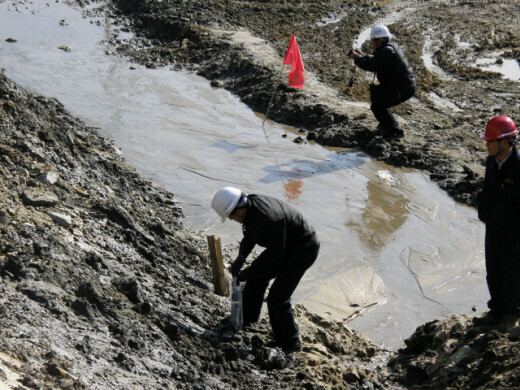hankyoreh
Links to other country sites 다른 나라 사이트 링크
Unsafe mercury levels detected at Four Rivers site

A government study has revealed that sediment taken form a weir construction site along the Nakdong River in Dalsung, Gyeongsangbuk Province contains more than the U.S.-recommended level of mercury, a toxic heavy metal. It also revealed high concentrations of organic materials that deteriorate water quality.
According to a report on pollution levels in the sediment at the Dalsung Weir construction site announced by the Minister of Land, Transport and Maritime Affairs’s Four Major Rivers Restoration Project headquarters on Thursday, a test by the Korea Water Resources Corporation’s sewage analysis center failed to detect any mercury, but analysis by the National Institute of Environmental Research (NIER) turned up 0.16mg of mercury per 1kg of sediment.
This is higher than the 0.15mg per 1kg of sediment level recommended by the U.S. National Oceanic and Atmospheric Administration (NOAA) in order to prevent adverse effects on aquatic life. Since South Korea has not yet set environmental standards for river sediments, it is currently using soil pollution standards.
The Four Major Rivers Restoration Project headquarters said the contrasting results are due to the differing dates in which the two investigative bodies collected their samples, and that the detected concentration of mercury was less than the 10mg per 1kg level of concern for soil pollution. Experts are pointing out, however, that unlike on land, harmful materials can dissolve in water, harming living creatures or exposing living things to harm through the food chain, so aquatic pollution levels need to be strictly controlled by adhering to the U.S.-recommended levels instead of the soil pollution standards.
Lim Hee-ja, director of the Masan, Changwon, Jinhae chapter of the Korean Federation for Environmental Movement (KFEM), said that because the Nakdong River provides drinking water for the Yeongnam region, precise studies of the sediment pollution, which was dropped from the previous environmental impact study, needed to be carried out.
Meanwhile, some are pointing out that since the sediments extracted from the Dalseong site contain not just pollutants, but large amounts of organic matter, it could pollute the water quality during dredging or be unusable as refill material after dredging. Analysis by the Korean Society on Rivers and Streams revealed 35,000-46,000ppm of organic material. Catholic University of Pusan Environmental Engineering Professor Kim Jwa-kwan said the sediments dredged up from the Dalsung levy site smelled terrible, and that if that is the case, it is possible that as they stored the sediments from nearby fields, organic material decomposed. The Four Major Rivers Restoration Project headquarters plans to dredge some 440 million cubic meters of sediment along the Nakdong River, and it plans to use the highly polluted soil as fill material in agricultural fields after cleansing it.
Please direct questions or comments to [englishhani@hani.co.kr]
Editorial・opinion
![[Editorial] Does Yoon think the Korean public is wrong? [Editorial] Does Yoon think the Korean public is wrong?](https://flexible.img.hani.co.kr/flexible/normal/500/300/imgdb/original/2024/0417/8517133419684774.jpg) [Editorial] Does Yoon think the Korean public is wrong?
[Editorial] Does Yoon think the Korean public is wrong?![[Editorial] As it bolsters its alliance with US, Japan must be accountable for past [Editorial] As it bolsters its alliance with US, Japan must be accountable for past](https://flexible.img.hani.co.kr/flexible/normal/500/300/imgdb/original/2024/0417/6817133413968321.jpg) [Editorial] As it bolsters its alliance with US, Japan must be accountable for past
[Editorial] As it bolsters its alliance with US, Japan must be accountable for past- [Guest essay] Amending the Constitution is Yoon’s key to leaving office in public’s good graces
- [Editorial] 10 years on, lessons of Sewol tragedy must never be forgotten
- [Column] A death blow to Korea’s prosecutor politics
- [Correspondent’s column] The US and the end of Japanese pacifism
- [Guest essay] How Korea turned its trainee doctors into monsters
- [Guest essay] As someone who helped forge Seoul-Moscow ties, their status today troubles me
- [Editorial] Koreans sent a loud and clear message to Yoon
- [Column] In Korea’s midterm elections, it’s time for accountability
Most viewed articles
- 1[Column] The clock is ticking for Korea’s first lady
- 2[Editorial] When the choice is kids or career, Korea will never overcome birth rate woes
- 3[Guest essay] How Korea turned its trainee doctors into monsters
- 4[Editorial] As it bolsters its alliance with US, Japan must be accountable for past
- 5S. Korea, Japan reaffirm commitment to strengthening trilateral ties with US
- 6Korea, Japan jointly vow response to FX volatility as currencies tumble
- 7Gangnam murderer says he killed “because women have always ignored me”
- 8Japan officially says compensation of Korean forced laborers isn’t its responsibility
- 9[News analysis] After elections, prosecutorial reform will likely make legislative agenda
- 10‘Right direction’: After judgment day from voters, Yoon shrugs off calls for change